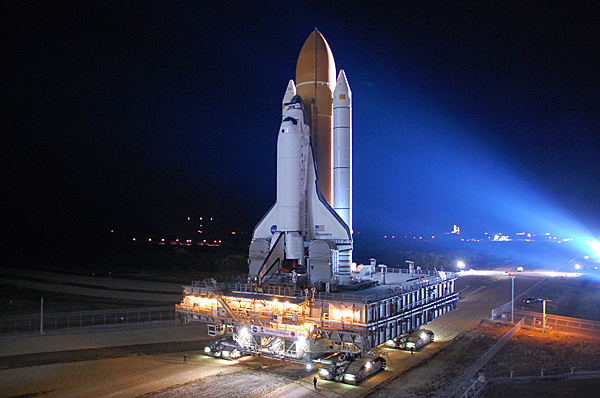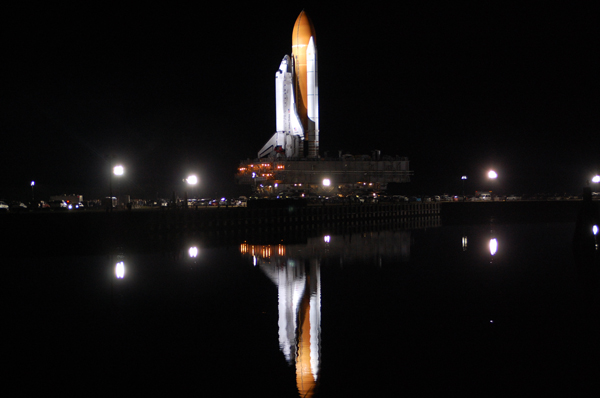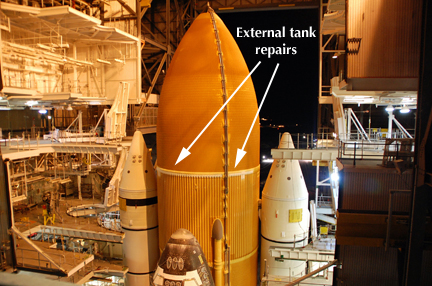Shuttle Discovery hauled back to launch pad after external tank repairs
Editor's note...
CBS News
KENNEDY SPACE CENTER, FL--With repairs to its external tank complete, engineers hauled the shuttle Discovery back to launch pad 39A overnight Monday for work to ready the ship for blastoff Feb. 24 on a flight to deliver critical spare parts, supplies and a final U.S. module to the International Space Station.
Carried by a powerful crawler-transporter, Discovery and its mobile launch platform began slowly rolling out of NASA's Vehicle Assembly Building at 7:58 p.m. EST (GMT-5), witnessed by scores of Kennedy Space Center workers who gathered nearby to watch what is expected to be Discovery's final trip to the pad. The 3.2-mile journey ended at 2:53 a.m. Tuesday when the shuttle's mobile launch platform was lowered onto supports at pad 39A.
"I have full confidence we've done everything we need to do on that tank," Stephanie Stilson, the engineer in charge of Discovery's ground processing, told CBS News. "Seeing those guys work and knowing how hard they worked to do the modifications, I have confidence in the way the shuttle program works and the fact that they're always investigating and asking more questions, more so than I've ever heard in the past."
Shuttle program managers plan to conduct a flight readiness review Feb. 10, followed by an executive-level review by senior NASA managers Feb. 18. Assuming no additional problems develop, the agency hopes to restart Discovery's countdown at 3 p.m. Feb. 21, setting the stage for launch Feb. 24 at 4:50:19 p.m.
NASA originally hoped to launch Discovery on its 39th and final flight Nov. 1, but the mission was repeatedly delayed, first by relatively minor technical problems that pushed launch to Nov. 5 and then by a gaseous hydrogen leak in a vent arm attached to the external tank.
The hydrogen leak was quickly resolved, but engineers also discovered cracks in structural rib-like "stringers" in the shuttle's external tank that triggered what turned into a nearly four-month delay.
The stringers are used in the ribbed "intertank" compartment of the external tank that separates the liquid oxygen and hydrogen sections. Engineers initially found four stress-relief fractures in two adjacent stringers on the side of the tank facing the shuttle that apparently were the result of exposure to the extreme low temperature -- minus 423 degrees Fahrenheit -- of liquid oxygen.
Engineers repaired those cracks at the pad by splicing in pristine stringer segments and attaching "doublers" to provide additional strength.
After an instrumented fueling test Dec. 18, Discovery was hauled back to the Vehicle Assembly Building for X-ray inspections of the backside of the tank, which engineers could not carry out at the pad. Additional cracks were found in three stringers, prompting NASA managers to order installation of "radius-block" doublers on most of the remaining intertank stringers.
A detailed analysis of the cracks found to that point indicated manufacturing tolerance issues and problems with a specific batch of aluminum-lithium alloy used in most of the 108 intertank stringers that left them more brittle than usual and more susceptible to stress-relief fractures.
Testing showed the radius-block modifications would provide the required margin of safety, easing concerns about the tank's structural integrity and the possible loss of foam insulation during the climb out of the dense lower atmosphere that could pose a threat to the shuttle's fragile heat shield.
When all was said and done, the five cracked stringers were repaired using a combination of doublers and radius blocks and 94 were modified with radius blocks alone. Nine stringers were not modified, one because of access issues and eight others because they were made from a different lot of aluminum-lithium alloy.
As if the crack problem wasn't enough of a headache for NASA, one of Discovery's crew members -- flight engineer Timothy Kopra -- was injured in a bicycle mishap in Houston Jan. 15. He was replaced by veteran astronaut Stephen Bowen, who will take Kopra's place in two planned spacewalks.
Bowen and his crewmates -- commander Steven Lindsey, pilot Eric Boe, Nicole Stott, Michael Barratt and spacewalker Alvin Drew -- plan to fly to the Kennedy Space Center on Feb. 20 for the start of their countdown to launch.
- Posted at 03:01 PM, 01/31/11: Shuttle Discovery prepped for return to launch pad after external tank repairs
- Updated at 10:15 PM, 01/31/11: Shuttle leaves Vehicle Assembly Building
- Updated at 07:30 AM, 02/01/11: Shuttle reaches launch pad
CBS News
KENNEDY SPACE CENTER, FL--With repairs to its external tank complete, engineers hauled the shuttle Discovery back to launch pad 39A overnight Monday for work to ready the ship for blastoff Feb. 24 on a flight to deliver critical spare parts, supplies and a final U.S. module to the International Space Station.
 |
| The space shuttle Discovery begins the six-hour trip from the Vehicle Assembly Building to launch complex 39A Monday evening. NASA has completed repairs to prevent cracks from forming in external tank ribs, or stringers, like those that derailed plans to launch Discovery last November. (Photo: CBS News/William Harwood) |
Carried by a powerful crawler-transporter, Discovery and its mobile launch platform began slowly rolling out of NASA's Vehicle Assembly Building at 7:58 p.m. EST (GMT-5), witnessed by scores of Kennedy Space Center workers who gathered nearby to watch what is expected to be Discovery's final trip to the pad. The 3.2-mile journey ended at 2:53 a.m. Tuesday when the shuttle's mobile launch platform was lowered onto supports at pad 39A.
"I have full confidence we've done everything we need to do on that tank," Stephanie Stilson, the engineer in charge of Discovery's ground processing, told CBS News. "Seeing those guys work and knowing how hard they worked to do the modifications, I have confidence in the way the shuttle program works and the fact that they're always investigating and asking more questions, more so than I've ever heard in the past."
Shuttle program managers plan to conduct a flight readiness review Feb. 10, followed by an executive-level review by senior NASA managers Feb. 18. Assuming no additional problems develop, the agency hopes to restart Discovery's countdown at 3 p.m. Feb. 21, setting the stage for launch Feb. 24 at 4:50:19 p.m.
 |
| The shuttle Discovery, shortly after beginning the 3.2-mile trip to pad 39A. (Photo: CBS News/William Harwood) |
NASA originally hoped to launch Discovery on its 39th and final flight Nov. 1, but the mission was repeatedly delayed, first by relatively minor technical problems that pushed launch to Nov. 5 and then by a gaseous hydrogen leak in a vent arm attached to the external tank.
The hydrogen leak was quickly resolved, but engineers also discovered cracks in structural rib-like "stringers" in the shuttle's external tank that triggered what turned into a nearly four-month delay.
The stringers are used in the ribbed "intertank" compartment of the external tank that separates the liquid oxygen and hydrogen sections. Engineers initially found four stress-relief fractures in two adjacent stringers on the side of the tank facing the shuttle that apparently were the result of exposure to the extreme low temperature -- minus 423 degrees Fahrenheit -- of liquid oxygen.
Engineers repaired those cracks at the pad by splicing in pristine stringer segments and attaching "doublers" to provide additional strength.
 |
| Structural stiffeners were added to rib-like 'stringers' in the shuttle Discovery's external tank to prevent cracks from forming. Foam insulation sprayed over the repaired areas appears lighter than the surrounding foam. (Photo: CBS News/William Harwood) |
A detailed analysis of the cracks found to that point indicated manufacturing tolerance issues and problems with a specific batch of aluminum-lithium alloy used in most of the 108 intertank stringers that left them more brittle than usual and more susceptible to stress-relief fractures.
Testing showed the radius-block modifications would provide the required margin of safety, easing concerns about the tank's structural integrity and the possible loss of foam insulation during the climb out of the dense lower atmosphere that could pose a threat to the shuttle's fragile heat shield.
When all was said and done, the five cracked stringers were repaired using a combination of doublers and radius blocks and 94 were modified with radius blocks alone. Nine stringers were not modified, one because of access issues and eight others because they were made from a different lot of aluminum-lithium alloy.
As if the crack problem wasn't enough of a headache for NASA, one of Discovery's crew members -- flight engineer Timothy Kopra -- was injured in a bicycle mishap in Houston Jan. 15. He was replaced by veteran astronaut Stephen Bowen, who will take Kopra's place in two planned spacewalks.
Bowen and his crewmates -- commander Steven Lindsey, pilot Eric Boe, Nicole Stott, Michael Barratt and spacewalker Alvin Drew -- plan to fly to the Kennedy Space Center on Feb. 20 for the start of their countdown to launch.